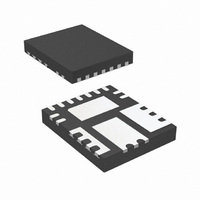IR3831WMTR1PBF International Rectifier, IR3831WMTR1PBF Datasheet - Page 19

IR3831WMTR1PBF
Manufacturer Part Number
IR3831WMTR1PBF
Description
IC REG SYNC BUCK 8A 15-QFN
Manufacturer
International Rectifier
Series
SupIRBuck™r
Datasheet
1.IR3831WMTR1PBF.pdf
(32 pages)
Specifications of IR3831WMTR1PBF
Applications
Converter, DDR
Voltage - Input
1.5 ~ 16 V
Number Of Outputs
1
Voltage - Output
0.6 ~ 14.4 V
Operating Temperature
-40°C ~ 125°C
Mounting Type
Surface Mount
Package / Case
15-PowerVQFN
Part Status
Preferred
Package
PQFN / 5 x 6
Circuit
Single Output
Iout (a)
8
Switch Freq (khz)
250 - 1500
Input Range (v)
1.5 - 16
Output Range (v)
0.7 - 0.9*Vin
Ocp Otp Uvlo Pre-bias Soft Start And
PGOOD + EN + OVD + DDR Tracking
Server Storage
Yes
Routers Switches
Yes
Base Station Telecom
Yes
Lead Free Status / RoHS Status
Lead free / RoHS Compliant
Other names
IR3831WMTR1PBFTR
Output Capacitor Selection
The voltage ripple and transient requirements
determine the output capacitors type and values.
The criteria is normally based on the value of the
Effective Series Resistance (ESR). However the :
actual capacitance value and the Equivalent Series
Inductance
components. These components can be described
as
Δ
Feedback Compensation
The IR3831W is a voltage mode controller. The
control loop is a single voltage feedback path
including error amplifier and error comparator. To
achieve fast transient response and accurate
output regulation, a compensation circuit is
necessary. The goal of the compensation
network is to provide a closed-loop transfer
function with the highest 0 dB crossing frequency
and adequate phase margin (greater than 45
Since the output capacitor has a major role in the
overall
determines the result of transient response,
selection of the capacitor is critical. The
IR3831W can perform well with all types of
capacitors.
As a rule, the capacitor must have low enough
ESR to meet output ripple and load transient
requirements.
The goal for this design is to meet the voltage
ripple requirement in the smallest possible
capacitor size. Therefore it is advisable to select
ceramic capacitors due to their low ESR and ESL
and small size. Eight of the Panasonic ECJ-
2FB0J226ML (22uF, 6.3V, 3mOhm) capacitors is
a good choice.
V
Δ
Δ
Rev 14.0
o
I
V
Δ
L
=
o
V
=
o
Δ
Δ
=
(
Δ
Inductor
V
V
ESL
Output
V
o
o
performance
o
(
(
ESR
ESR
)
(
C
=
)
(ESL)
)
)
⎛
⎜ ⎜
⎝
=
V
+
=
8
in
Δ
voltage
Δ
ripple
*
V
L
I
−
C
L
Δ
o
V
o
(
I
*
ESL
o
L
*
ESR
⎞
⎟ ⎟
⎠
F
)
*
s
current
of
are
+
ESL
ripple
Δ
V
the
o
(
other
C
)
..........
converter and
contributing
..........
o
.....
).
(15)
The output LC filter introduces a double pole,
–40dB/decade gain slope above its corner
resonant frequency, and a total phase lag of 180
(see figure 12). The resonant frequency of the LC
filter is expressed as follows:
Figure 12 shows gain and phase of the LC filter.
Since we already have 180
output filter alone, the system runs the risk of
being unstable.
The IR3831W uses a voltage-type error amplifier
with high-gain (110dB) and wide-bandwidth. The
output of the error amplifier is available for DC
gain control and AC phase compensation.
The error amplifier can be compensated either in
type II or type III compensation.
Local feedback with Type II compensation is
shown in Fig. 13.
This method requires that the output capacitor
should have enough ESR to satisfy stability
requirements. In general the output capacitor’s
ESR generates a zero typically at 5kHz to 50kHz
which is essential for an acceptable phase
margin.
The ESR zero of the output capacitor is
expressed as follows:
0 dB
Gain
F
F
LC
ESR
Fig. 12. Gain and Phase of LC filter
=
2
F
=
LC
∗
2
π
-40dB/decade
Frequency
∗
π
L
1
*ESR*C
o
∗
IR3831WMPbF
1
C
o
..........
-180
o
0
Phase
0
o
..........
0
phase shift from the
..........
F
LC
..........
..........
Frequency
.......
..
(16)
19
(17)
o











